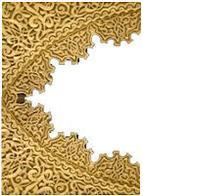|
|
|
Questions-Responses on History |
(Translated into English by Mr Taoufiq GAZOULIT) |
48- QUESTION : A friend from Rabat just sent me your article on “Al Quds: Capital Martyrdom” in which you claim the presence of Palestinians on the land of Palestine for 2000 years. Does this existence go back to an earlier date, the 10th century before Christ at the time of Saul and of David? Are they not the Philistines, former people who established themselves between Syria, the Mediterranean and Joppe (this region corresponds to which current city?) and whose major cities were Gaza, Ascalon, Asdod, Akron and Gad. We will then prove the presence of Palestinians on their land since a long time ago, and it would destroy at the same time the fallacious arguments of the Zionists. What do you think ? 48- ANSWER : You have committed a mistake in referring to an article in my book “peace in Palestine through Al Quds” published in 1998 from the series “Mission of Islam” volume 4, leaving another article which answers your question. In fact, the first article inserted on page 35 of the book “Al Quds: Capital Martyrdom” speaks only of Jerusalem in its current state. It was preceded on page 13 by an important study called “Al Quds: Universal center of the faith”, where you can read at the end of the page the last 4 lines where I say explicitly: “Al Quds is an Arab city. It will remain forever because it was legitimately since thousands of years when Arabs of Canaan, migrating from the Arabian Peninsula, were its original founders".
111- QUESTION :I know that you receive a lot of emails and I hope that you will help me inch’Allah, or at least show me the right path. I am in search of information on the origin of Beni Mester, near Tlemcen, and I would point out that the information on this region (tribe) is much reduced or not available. Beni Mester is an old village which is seven centuries old, situated 10km from Tlemcen. I know that there was a village in Morocco of the same name, sometimes called Beni Mestara. Surely there should be a link between the two, but this remains to be proved. I’ve recently discovered that Ahmed Ben Gannoun’s (late grandson of Ahmed Ben Idris) sons are much known in Beni Mestara (see Al Dourar Al Bahia). A friend of mine has told me that according to Al Achmaoui, the Beni Mester is a fraction of Idrisside. I have never succeeded in confirming this information, but I am not that far. If by any chance you have information on this subject, I would be very grateful if you would communicate them to me. Besides, the Cheikh Tijani was a contemporary of the great scholar of tlemcen, the Sheikh Mohammed Ibn Abderrahman Al Yabderi. This latter died at the end of the 18th century (1780-1800). Do you know if they had met ? 111- ANSWER : In my book, “encyclopaedia Maghrebine” (T4 p274) on Beni Messara or Mestara, a tribe containing towns, one of which is Wazzan, on the mountain of the “Rayhane”. Among its localities, I have cited two: Beni Mestar and Tlemcoun. According to a study which I have intergrated into my book on the Souss, it appears that various localities or tibes have the same name in North Africa, especially Atlas (High, middle and Anti-Atlas which means Souss). As for the person named Kanoun, it may refer to Guennoun, a family of Mestara (see my book on Wazzan p57, edition Dar Dmama, Wazzan). For the last question regarding the contemporary of Cheikh Tijani, Mohamed Ibn Abderrahman El Yabderi, it does exist Ibn Yabderi of Tlemcen under the same name of El Fakhkhar by A. skirej in his book “Raf’ Anniqab” (T3 p212) citing an epistle expressing to Cheikh Tijani with ardour and vehemence his indelible intimacy and affection.
139- QUESTION : Where is Lalla Fatima Zahra, daughter of the Prophet, buried ?
139- ANSWER : Lalla Fatima Zahra died at the age of twenty nine years old in the year eleven of the Hegire. She was buried at night in the main cemetery El Baqiy of El Medina. The place is the mosque, place of the funeral prayer. But, another version is more accurate: this tomb is located in the Zaouia, so called “Dar E’diyl” in the same Baqiy. This fact is confirmed by Abdellah Ibn Jaefar, Ali’s nephew (refer to TABAQAT Ibn Saad, p.27).
|


